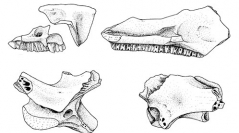

 Geodiversitas
27 (3) - Pages 413-441
Geodiversitas
27 (3) - Pages 413-441The Béon 1 vertebrate locality, formerly known as “Montréal-du-Gers” in southwestern France, has yielded a rich fauna of amphibians and squamate reptiles of late early Miocene (MN 4; Orleanian) age. It represents the first herpetofauna of that age described from Western Europe. The assemblage from Béon 1 includes 26 species (three species of salamanders, two of anurans, seven of lizards, and 14 of snakes). At least as far as snakes are concerned, the appearance of such a diversity of taxa is typical of the zone MN 4. The presence of this diverse snake assemblage at Béon 1 demonstrates that the wave of modern taxa that invaded Central Europe during MN 4 also reached Western Europe. The number and diversity of natricine snakes appear to be a characteristic of the late early Miocene (MN 4) and also of the early middle Miocene. Although a change apparently took place between the herpetofaunas from MN 4 and MN 6 in Central Europe, Béon 1 shows that the faunas were not altered significantly during that period in Western Europe. Béon 1 has produced the earliest Pseudopus laurillardi (Anguidae), Python europaeus (Boidae), Coluber pouchetii, Texasophis meini, Neonatrix europaea and Neonatrix natricoides (Colubridae). It has also yielded one of the earliest Varanus (Varanidae) and perhaps the youngest Natrix merkurensis (Colubridae). The knowledge of the anatomy of the anguid lizard Pseudopus laurillardi is increased by the description of a posterior braincase. The abundance of aquatic amphibians and snakes confirms the presence of lacustrine/swampy environment.
Amphibia, Squamata, Reptilia, Miocene, France